
Traditional Spas from Around the World: A Guide to International Spa and Bathhouse Cultures, from Turkish Baths to Japanese Onsen
- NOV 5, 2021
- Category : GUIDES
- WRITTEN BY: Admin
Hello, and welcome to Experience Days’ guide to spa and bathhouse cultures from around the world.
That’s right – grab your passport. ‘Cause we’re about to take a whistle-stop tour of traditional spas from Europe, Asia, and beyond.
Along the way, we’ll explore the individual practices of different spa-ing nations, before revealing where you can try some of them yourself – right here, in the UK! From Finnish saunas to Russian banyas, Moroccan hammams to Mexican temazcal – we’ve everything you need to know about sweating, steaming and soaking abroad.
If that all sounds fascinating, but you’d rather just browse spa days and breaks, please head here.
Otherwise, let’s begin by considering…
The Power of Water
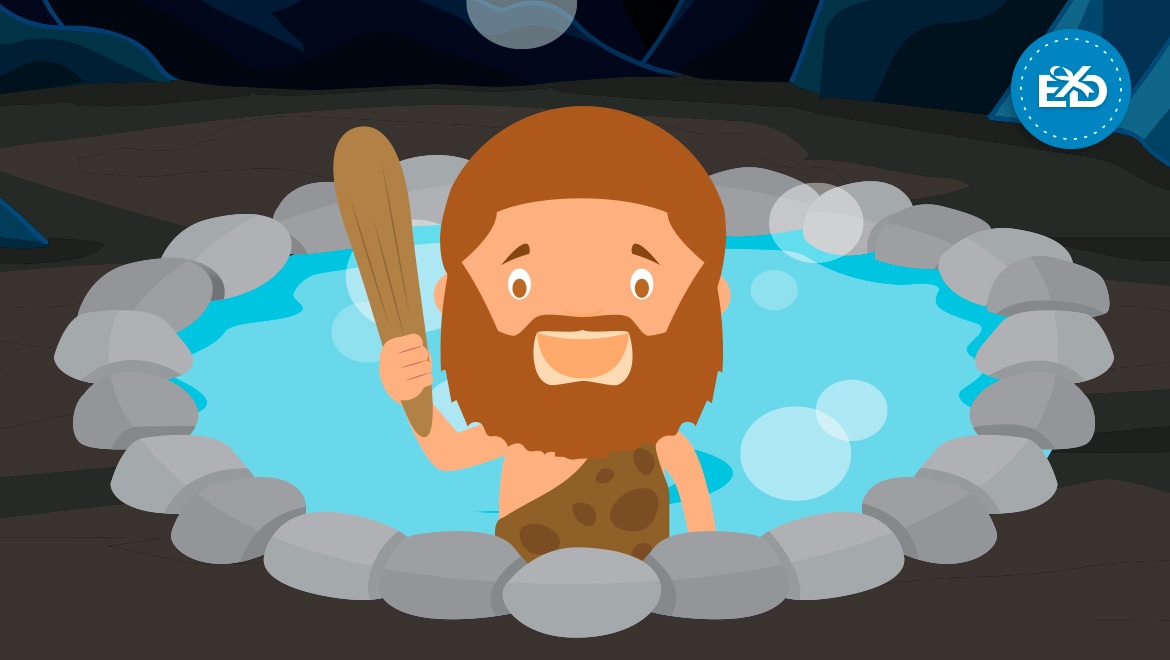
Humankind’s belief in the unique power of water is central to the development of all the world’s spas. Even some of our earliest ancestors are thought to have revered water for its miraculous properties, and there’s some archaeological evidence to suggest they partook in proto spa rituals. Clay fragments and vessels unearthed near idiosyncratic or isolated water sources imply that these were places of pilgrimage – perhaps where prehistoric humans came to heal, cast magic, or convene with the spirit world. How could they know, in their reverie, that others would return to do the same for millennia afterwards?
With the rise of early civilisations, water became no less associated with the divine. Indeed, the majority of world religions – from Christianity to Hinduism, Buddhism to Islam – have always ascribed to it a uniquely mystical significance. Transient and changeable, water is both a source and symbol of life – capable of purifying the body and soul. Bathing in sacred waters, like the Ganges River, has long been practised as a means of spiritual cleansing, and several ancient cultures devised elaborate rituals which reinforced the link between water, cleanliness and godliness.
Spa Facts

The earliest known public bath is the Great Bath discovered at Mohenjo-daro, in Pakistan. It’s part of a large complex built by the people of the Indus Valley civilisation around 2500 BCE, and it measures 83 square metres.
No one knows exactly why they built it, but most scholars agree the bath would have served a religious purpose – perhaps in purification or healing rituals.
Next, we’ll discuss perhaps history’s most famous bathers. Who? But of course…
The Ancient Romans

Although public bathing had been around for thousands of years, the ancient Romans took it to another level entirely. Sure, they weren’t the first to build grand public baths – but the sheer scale and complexity of Roman thermae surpassed everything that had gone before them.
The Baths of Caracalla, built around AD 216 in southern Rome,
are now some of the best-preserved ruins of
an ancient Roman thermae
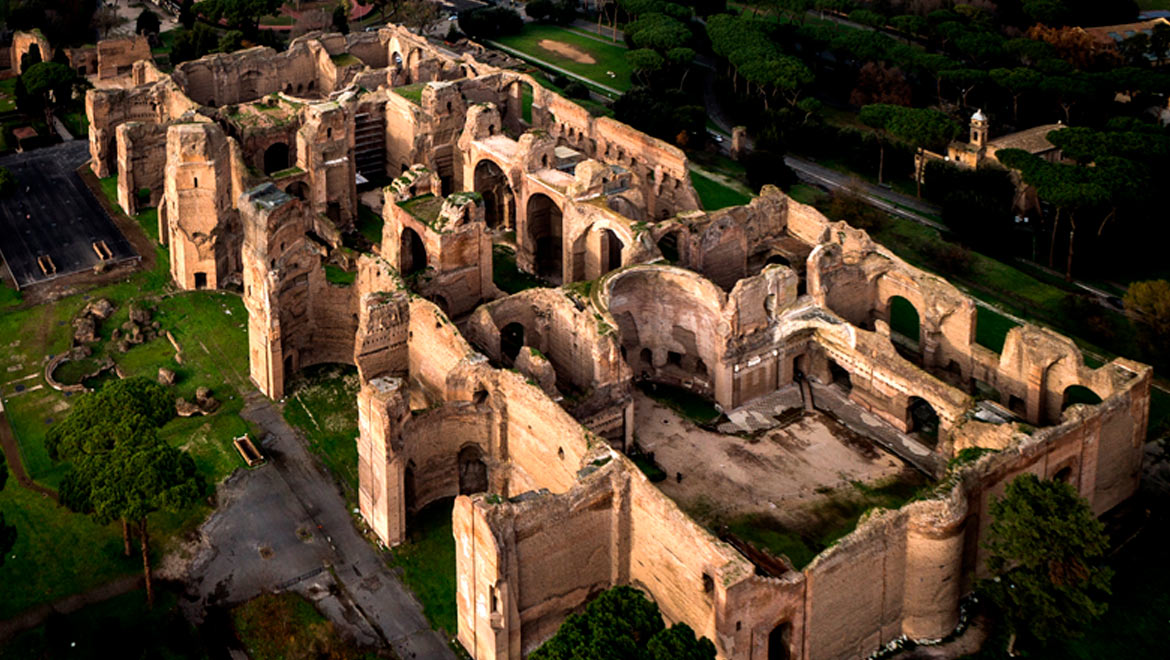
Bodyflight is relatively low impact, so other injuries are very rare. However, there are still some people who should give it a miss. Pregnant women and those who’ve previously dislocated a shoulder are advised against indoor skydiving. Likewise, those under the influence of alcohol or non-prescribed drugs!
Typical features included:
Seems pretty familiar, eh?
Ancient Roman spa-goers visited each room in succession for maximum purification and relaxation. At larger complexes, they could also make use of libraries, lecture halls, barbershops, food-sellers and ornate formal gardens.
Thermae and the smaller balnea were at the heart of Roman social and recreational life, and they were built in great numbers throughout the empire. Bathing was enjoyed by both men and women, and entry fees were usually within the means of most free citizens.
In most cases, aqueducts supplied the baths with ample water which was then heated in massive lead boilers over a wood-fuelled furnace. In other locations, spas were built over naturally occurring thermal springs. The Roman Baths in Bath, for example, were constructed in around AD 70 to utilise the mineral-rich, heated waters of the local well head.
The Roman Baths, Bath © Diego Delso/WikiCommons

Ancient Roman bathing practices had a widespread and lasting influence on spa culture. The modern spa layout owes a great deal to Roman thermae, and many of the spa towns they founded remain popular resorts to this day.
Indeed, if you’d like to bathe like an ancient Roman, you can still do so at Thermae Bath Spa. Make the journey to enjoy those very same naturally warm and mineral-rich waters, plus all the facilities of a top-class contemporary spa.
Spa Facts
Elizabeth Taylor as Cleopatra in the eponymous 1963 film (not bathing in donkey milk apparently)

The ancient Egyptians were also fastidious bathers; washing themselves several times a day using a perfumed paste made from ash and clay. They believed that cleanliness brought a person closer to the gods and was therefore vital for entry to the afterlife.
It was common for both men and women to remove all hair from their bodies; preferring to wear wigs and draw eyebrows on instead. Other cosmetics were popular too, and legend has it Cleopatra took regular baths in donkey’s milk for her complexion!
Bathhouses Around the World
Now that we’ve talked a bit about history’s most famous spa-lovers, let’s explore a few more bathing traditions from around the world. Some were directly influenced by the Romans, whereas others share only distant origins or none at all.
Most can be experienced right here in the UK, so watch out for our top recommendations throughout.
Here goes…
Hammams
Cağaloğlu Hamam, Istanbul
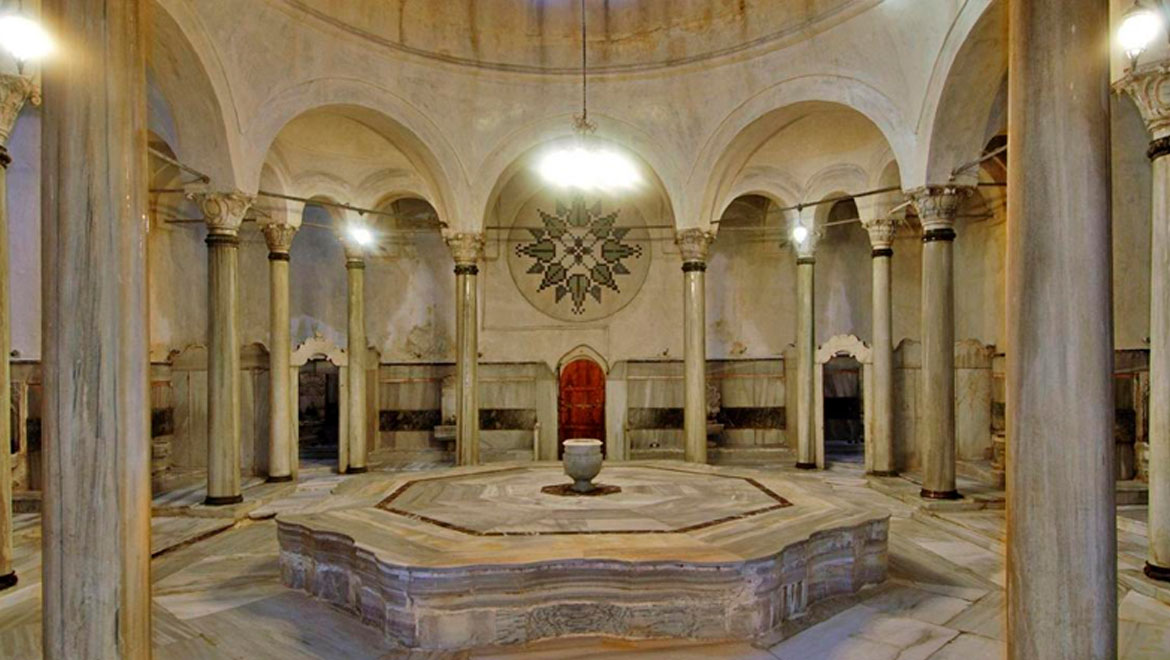
Most often associated with Turkey (hence the synonymous term “Turkish bath”), hammams were popularised around AD 600 when Roman bathing practices were adapted to meet the needs of an emergent Islamic faith. This demanded followers make regular ablutions before prayer, and many new bathhouses were built close to mosques as a result. Over the centuries, these hammams became common gathering places for Muslim men and women, not just in Turkey but across the Arab world too – most notably in Morocco, which claims its own distinct hammam experience.
A traditional hammam comprises three interconnected rooms in which the temperature varies from hot to warm to cool. Guests start off in the hot room, where an attendant, called a tellak, vigorously massages and scrubs them with an abrasive mitt, or kese. They then head to the warm room to wash, before relaxing and refreshing inside the cool room. Medieval Muslims were sticklers for cleanliness who preferred bathing in steam or running water to soaking in ‘dirty’ immersion pools. This marks a distinction between their hammams and Roman thermae – though they share many other similarities.
Turkish baths became popular in Britain during the 19th century, and though few Victorian-style baths remain open today, plenty of places still offer an authentic hammam experience. These promise to cleanse pores, exfoliate skin and increase blood flow – leaving you radiant and relaxed.
To check out a variety of spa days, browse our full range here.
Spa Treatments from Around the World
Today, spas offer a bewildering range of treatments from all over the world. Many of these are drawn from traditions dating back hundreds (if not thousands) of years in their countries of origin. Here are some of the most popular…

Swedish Massage
This ‘classic’ massage treatment uses a combination of gliding, kneading, rubbing, shaking and tapping to relieve muscle tension, improve circulation and leave clients deeply relaxed. The technique is often attributed to Pehr Henrik Ling (1776–1839), a prominent Swedish gymnastics practitioner. In fact, Dutchman Johann Georg Mezger was more likely the inventor – but, unfortunately for him, the name’s stuck!
Enjoy a Swedish – sorry, Dutch – massage at home, here.

Thai Massage
This energetic, full-body treatment is said to have been created over 2,500 years ago by Shivago Komarpaj, the Buddha’s physician. Clients remain clothed while the practitioner manipulates their body into various yoga-like positions. The intention is to unblock the body’s energy lines, boosting the circulatory and lymphatic systems.
Try it for yourself, here.

Ayurveda
Ayurvedic medicine was developed in India over three thousand years ago, making it one of the world’s oldest known healing systems. It takes a holistic approach to wellbeing, focusing on the balance between body, mind and spirit. After an initial consultation, an Ayurvedic practitioner will usually prescribe a course of treatments that can include herbal supplements, diets, detox (Panchakarma), massage and Shirodhara – a technique that involves dripping medicated liquids on the forehead.

Shiatsu Massage
Shiatsu is a form of Japanese acupressure massage based on traditional Chinese principles. The word itself means ‘finger pressure’, but the system also incorporates palm pressure, stretches and other massage techniques. It targets the same points on the body as acupuncture, likewise seeking to release blocked energy responsible for a variety of health conditions.

Halotherapy
In the 1840s, the Polish state authority for occupational health, Dr Felix Bochkowsky, noticed something interesting. Whereas Polish metal and coal miners suffered with all manner of nasty respiratory ailments, their peers in the salt mines had healthier lungs than even average workers. He went on to publish a book on his findings, before establishing the first salt cave (halotherapy) clinic, in Krakow. Today, salt cave therapies are still used to treat breathing problems, while supporting the immune, nervous and lymphatic systems.
Intrigued? Find out more, here.
Saunas

Did you know that sauna is the only Finnish word commonly used in the English language? Or that saunas were invented in Finland around two-thousand years ago?
Well, now you do.
The original saunas were probably pretty primitive structures made from animal skins and branches or dug into the ground. There would’ve been a wood fire and heated rocks over which water was thrown to create steam, or löyly. This created a warm refuge from the bitterly cold Finnish winter, as well as a clean, restorative environment for the whole family to unwind in. What’s more, it could also be repurposed for drying malts, smoking meat or – gulp – preparing the dead for burial!
Over time, the sauna developed into the familiar wood-panelled cabin with a stove and chimney to vent smoke (if it’s not electric). In Finland, there are now around two million – that’s one sauna for every 2-3 Finns! Typically, people use a sauna at least once a week. After showering, they relax in the hot steam until it becomes uncomfortable, at which point it’s customary to run out and jump into cold water or roll around in the snow. Back in the heat, silver birch branches can be used to lightly whip the body, thus relaxing muscles and improving circulation. The whole process is often repeated a few times.
Saunas can be found all over the UK – in your local leisure centre, gym or spa. For a truly authentic experience, however, head to London’s Finnish Church, where guests can break a sweat in their small but perfectly formed example.
Spa Facts
A typical hiking banya
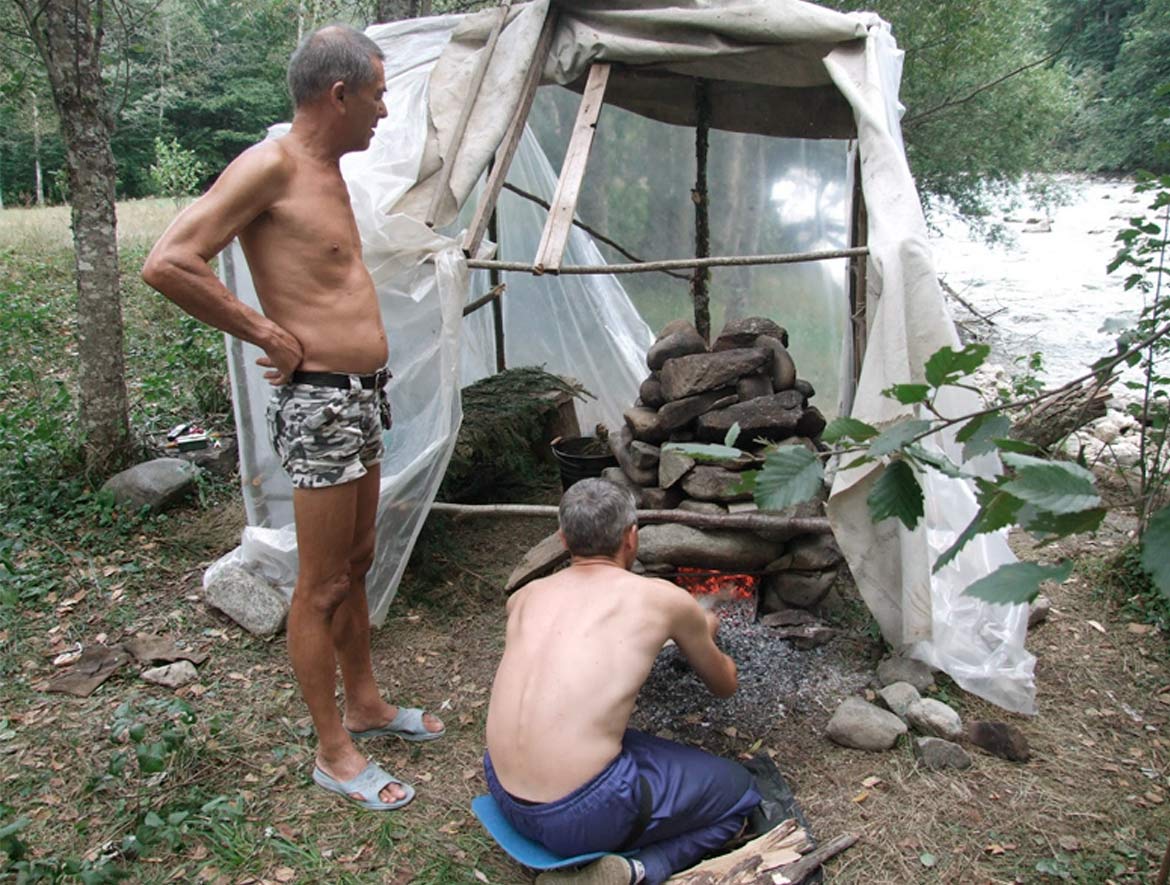
The Russian banya is almost identical to the Finnish sauna. Bathers likewise alternate between hot steam, chilly water/snow and enthusiastic birch twig (veniki) lashing.
‘Hiking banyas’ are popular among the Russian military and outdoorsy types. These makeshift structures are constructed from stones, branches and tarpaulins, and they work just like a regular banya – making use of a nearby lake or river for that invigorating icy plunge!
In Slavic mythology, Bannik was the banya spirit. Powerful and not altogether friendly, he would burn or even strangle disruptive bathers. Christian images were not permitted inside the bathhouse for fear of offending him and his demon companions!

Don’t let a cranky spirit put you off though – for an authentic banya experience in the UK, head to BANYA No.1 in London.
Onsen
Dōgo Onsen, Shikoku
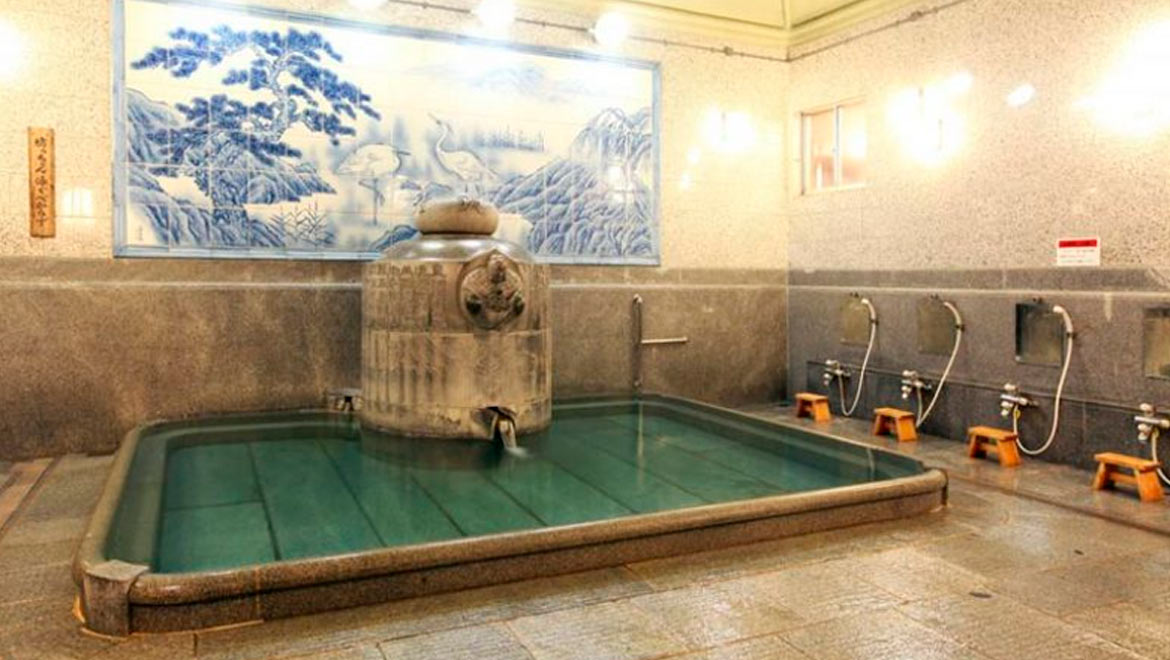
Onsen are Japanese thermal springs, and people have been bathing in them for thousands of years. Their popularity can be traced back to the spread of Buddhist principles (detachment, purification etc.) around the end of the 6th century – though it’s likely people were visiting their local hot spring long before then. In fact, it’s thought some onsen were first discovered by ancient hunters tracking wounded quarry. According to this theory, animals were instinctively drawn to the soothing waters, thus revealing them to their human pursuers.
Humans aren’t the only ones to use onsen! Here, snow monkeys enjoy a dip in the Jigokudani Yaen Koen park

Traditionally, men and women bathed in onsen together, but these days it’s far more common to have separate facilities or visiting hours. All guests are expected to wash themselves before entering, using the taps, buckets and toiletries provided. They’re then free to relax in the warm, mineral-rich water – long believed to confer a variety of health benefits. There are over two thousand registered onsen in Japan, many of them part of traditional ryokan – inns offering guests a taste of old-fashioned Japanese hospitality.
Unfortunately, the UK isn’t known for its plentiful spouting geothermal wonders. However, for a hot(ish) thermal spring experience, you should check out the spa at Matlock’s New Bath Hotel, in Derbyshire.

The Question of Nudity
Nudity is a necessary part of bathing, but we Brits have always been a bit prudish about it.
In other countries, however, it’s perfectly normal to hit the spa in your birthday suit rather than your bathing suit. In Japan, for example, onsen-users are given only a small ‘modesty’ towel – which they promptly put on their head once in the water!
Hammams are also a predominantly nude affair, while sauna etiquette varies from place to place. In Finland, naked men and women visit separately, but even mixed nudity is the norm for Austrians and Germans.
Jeez, maybe it’s time we loosened up a bit – it’s only the human body after all!
Temazcales

While the Finns were busy beating themselves with birch twigs and smoking meat in primitive saunas, another distant culture was discovering the benefits of regular steam bathing. Almost ten thousand kilometres away, the people of pre-Columbian Mesoamerica partook in regular sauna-esque rituals, known as temazcales.
Typically, a temazcal is a circular, domed building made of stone and mud. River rocks are heated on a fire and brought inside, where herb-infused water is splashed over them to create steam. The temazcal has no windows and only one small door which is closed during the ceremony. Up to around twenty people enter at a time, and the temperature rises rapidly in the dark, womb-like space.
The experience is usually led by a spiritual healer, or curandero. They manage the heat inside the room and guide participants through the process of sweating, reflection and renewal. Indigenous groups, including the Aztecs and the Mayans, believed emerging from the temazcal was akin to rebirth – and the ceremony was commonly used to purify the body after the exertions of battle or ritual ball games.
Today, temazcales are hailed as the latest trend in health and wellbeing. However, if you’d like to experience one for yourself in the UK, there aren’t that many options. Your best bet is to visit the Yuan Clinic and Traditional Medicine College, in Kent, where practitioner John Tindall offers a sweat lodge experience influenced by the native North-American equivalent of the temazcal.
Public bathing has been an integral part of societies around the world – and hammams, saunas, onsen and temazcales are still sought out for their proven and assumed wellness benefits.
Next, we’ll look at how the rise of European spa towns led to the development of the modern spa as we know it – the ultimate wellness destination.
The Birth of the Modern International Spa
The ancient Romans founded spa towns wherever they went, and in Europe this trend continued long after the mighty empire had fallen. Although the establishment periodically regarded bathing with suspicion – as a corrupter of morals or spreader of virulent diseases – the masses could never be deterred entirely. Indeed, wherever water bubbled from the ground, ordinary people flocked in search of relaxation, pleasure and miracle cures – and the aristocracy were never far behind.
Montecatini Terme, Tuscany

In 1326, a chalybeate spring was discovered in the town of Spa, Belgium. Over time, a health resort grew around it, just like those at Baden-Baden, Carlsbad, Aix-les-Bains, Montecatini Terme, and countless other thermal hot spots. Visitors came from far and wide to ‘take the waters’ – which usually involved bathing in the spring and drinking great quantities of its water. Such was the state of medicine back then, that treatments like these often represented a sick person’s best hope of getting better.
As you may have guessed, Spa later gave its name to all resorts of this type. By the mid-19th century, the principles of balneotherapy and hydrotherapy were embraced by Europe’s medical elite, and grand new spas were built with more than a nod to the architectural styles of their Roman predecessors. Amid neoclassical columns, archways and fountains, patients were subject to a regimen of daily water treatments, exercise, and dietary restrictions. This approach was adopted on both sides of the pond and, in 1820s America, the health spa at Saratoga Springs was the country’s most popular tourist destination.
A postcard from the Grand Union Hotel in Saratoga Springs, NY.
The world’s largest hotel at the time, it
was built to accommodate tourists visiting the local mineral spas

Around the turn of the century, people began to question the medicinal efficacy of drinking spring water, and this led to a decline in the practice. Spas now began to focus more on other health and beauty treatments – a shift facilitated by the rise of commercial cosmetics, as well as the rediscovery of alternative therapies from around the world.
After a mid-century slump, the new holistic spa went from strength to strength, and you know the rest. Modern spas come in all shapes and sizes – from the Downton-esque grandeur of Champneys Tring to the modern facilities at Brooklands, Surrey. Ultimately, however, they’re all founded on the same basic principle – namely, a belief in the unique power of water and heat, rest and relaxation, to heal and renew.
Thanks for reading!

On that note, we’ll end our (far from comprehensive) guide to spa and bathhouse cultures from around the world. We hope you’ve found it somewhat informative.
Ready for a break? To browse Experience Days huge range of restful spa and beauty experiences, head here.
Alternatively, if you’ve any questions or comments – please get in touch below. We’d love to hear from you!






